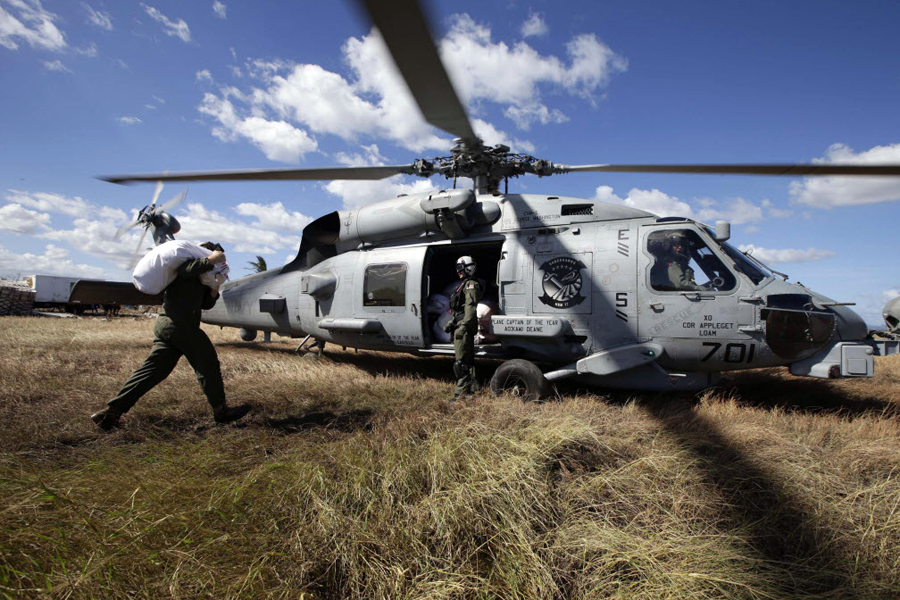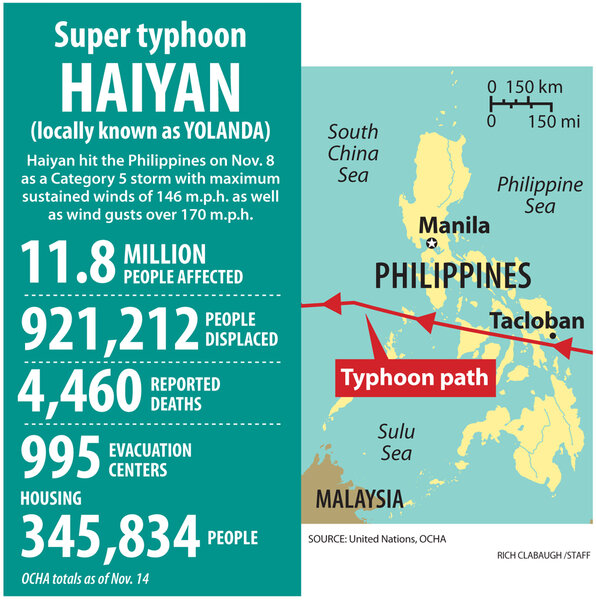Aid continues pouring to coastal cities stricken by Typhoon Haiyan
Loading...
A roundup of global news
As aid continued to pour into areas devastated by Typhoon Haiyan in The Philippines, the death toll became a point of contention between the country’s government and the international groups assisting in the recovery. The controversy arose against the backdrop of widespread criticism at the pace and scale of relief operations, which some observers say is unjustified.
A week after Typhoon Haiyan rammed through the central Philippines some areas along the devastated coast have become hubs of activity, with hundreds of international aid workers bolstering the efforts of government forces to help local residents rebuild their lives. A Reuters report today points to the gradual progress being achieved in the badly hit city of Tacloban on Leyte island, where food and water deliveries have taken off in recent days and a makeshift hospital is bustling with energy.
Captain Victoriano Sambale, a military doctor who since Saturday has treated patients in a room strewn with dirt and debris in Tacloban, which bore the brunt of the storm, said there had been a change in the pace in the response.
“I can see the international support coming here,” he said. “Day one we treated 600-plus patients. Day two we had 700-plus patients. Day three we lost our count.”
Relief operations received a boost yesterday when a US aircraft carrier arrived on the scene. American helicopters are now ferrying pallets of food and water to Tacloban. The Associated Press reported this morning that the helicopters have delivered 190 tons of supplies and flown nearly 200 sorties.
But the enormous logistics challenges and magnitude of the disaster mean that aid distribution remains patchy. Residents in some hard-to-reach coastal areas have yet to see help.
The Associated Press reported today from Guiuan, a city on the southeast coast of Samar island about 100 miles east of Tacloban, that local residents had set about rebuilding on their own after waiting for days for aid to arrive.
At 6 a.m., Dionesio de la Cruz was hammering together a bed, using scavenged rusty nails. He has already built a temporary shelter out of the remains of his house.
"We're on our own, so we have to do this on our own," the 40-year-old said as his wife and mother slept on a nearby table. “We're not expecting anybody to come and help us.”
There are now signs that help is on its way. The BBC wrote this morning that US helicopters were lifting off from the aircraft carrier to transport supplies to Guiuan. And additional relief crews are arriving by the hour, including a Norwegian navy vessel that docked near Tacloban Friday with 40 tons of rice, medicine and supplies. A British aircraft carrier is also en route.
Meanwhile, the estimates of how many peopled died in the storm diverged on Friday. The official death toll jumped to 3,621 (from 2,360 reported yesterday), according to the Philippines disaster relief agency. But a new tally by the UN put the figure at 4,460 based on its own reporting.
The UN’s report met with skepticism from Philippines officials, who cautioned against rushing to conclusions. Speaking with reporters in Manila, Eduardo del Rosario, chief of the National Disaster Risk Reduction and Management Council, added the cautionary tale of a city mayor dismissed from his post after overestimating the number of fatalities. The UN is now conducting a review of its figure, according to an agency spokesperson quoted by Reuters.
All parties agree on one thing: the toll is poised to climb further as recovery crews dig though debris and as some of the missing – officially estimated at 1,187 today – are confirmed dead.
The government has continued to defend its handling of disaster response in the face of criticism that it had been caught off guard by the storm. “In a situation like this, nothing is fast enough,” Interior Secretary Mar Roxas told journalists in Tacloban according to the BBC. “The need is massive, the need is immediate, and you can't reach everyone.”
An editorial in Time by John Crowley, a research affiliate at the Harvard Humanitarian Initiative, calls on the international media to stop “catastrophizing” the Philippine aid efforts. Criticism of disaster response and media scaremongering are common reactions to natural disasters, Mr. Crowley writes, recalling the examples of Hurricane Katrina and the Haiti earthquake. But critics often “miss the point,” undermining local communities’ efforts to rebuild.
When I talked with colleagues on the ground and friends who have worked in the Philippines, it became clear that these reports do not reflect the Philippines they know or the situation they are confronting. Worse, these reports are amplifying the problem. Here’s why:
After a disaster, there will always be delays in the delivery of aid. While planes and helicopters can arrive in 24 to 48 hours after the storm clears, massive deliveries can only arrive by ship, which can take several days to sail — longer if they have to sail around a massive storm. Worse, damaged ports may take weeks to fix. With severe damage like that in Tacloban, roads may be impassible for many days or weeks, making distribution of aid difficult.
It is time to look at how effectively international organizations are supporting a normally well-oiled (but now struggling) domestic response capacity, not how international aid shipments are arriving late.
How you can donate
As The Philippines begins the process of healing and rebuilding after the devastating Typhoon Haiyan, aid groups are moving quickly to offer everything from safe drinking water to medical care. Here are some of the organizations that are offering help. You can click on the highlighted text for information on how to donate.
1. The International Committee of the Red Cross and the Philippine Red Cross are accepting donations and coordinating disaster relief on location. Follow the Philippine Red Crosson Facebook and Twitter for updates.
2. World Food Program, which delivers emergency food aid, is accepting donations online and through PayPal.
3. US Fund for UNICEF is accepting donations online to provide children affected by the typhoon with drinkable water, hygiene supplies, food and shelter.
4. Catholic Relief Services aims to provide 100,000 families with shelter, water, sanitation, and essential living supplies. It is accepting donations online.
5. American Jewish Joint Distribution Committee is accepting online donations for addressing survivors’ immediate needs.
6. World Vision is accepting online donations to help 400,000 people meet the most urgent needs of food, clean water, and emergency shelter.
7. Médecins Sans Frontières (Doctors Without Borders) is rushing personnel and supplies to provide medical care in the affected areas. It is accepting donations online.
8. The Salvation Army is on the ground meeting the immediate needs of survivors, providing food, water, and shelter. It is accepting donations online.
9. Caritas Manila, a Catholic charity, is accepting donations online and through wire transfers.
10. International Rescue Committee has mobilized an emergency response team to provide clean water and hygiene and sanitation supplies to survivors. It is accepting donations online.
11. Global Giving, a charity fundraising website, is accepting donations to its Typhoon Haiyan Relief Fund to support immediate relief and longer-term recovery.








